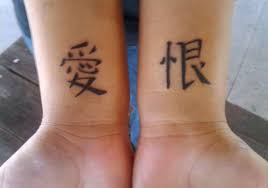If you asked a million different people to define love, you would be buried in a million different symphonies of collected words. It is a construct nearly impossible to define. It looks different for everyone. For some, it is passion and chemistry. For others, it is the feeling of safety or emotional protection. We can even find endless examples, especially in the media, where love is expressed through violence and control. There is romantic love, platonic love, maternal love, self-love, etc. and they all take on distinctive forms. Though we may not all agree on the precise classification of love, we all know what it feels like. We can recognize its presence within us and in others. It is one of the most desired and longed-for experiences among all humans.
It’s less coveted counterpart, hate, is even more of an experiential mystery. It is often a masquerade for jealousy, resentment, prejudice, anger, hurt, guilt, shame. Hate is complex and rarely has one distinct cause. Our collection of experiences, insecurities, and learned beliefs are major contributors to its creation. And unless you are the Dalai Lama, you certainly know the feeling of hatred. We have all been on the giving and receiving end of hate.
So we know it is possible for all humans to be capable of both love and hate, but is it possible to love and hate at the same time, to feel both sentiments for the same subject? According to researchers, not only is it possible, but it is expected. Semir Zeki, a professor at University College London, explains that the stronger the feelings of love you experience for someone, the stronger your hatred will be. This dichotomy can be defended by the findings that the brain experiences hate and love through the same neural circuits. The putamen and the insula are the specific structures to blame. The Insula regulates emotional valance, our evaluation of something or someone as good/bad or pleasant/unpleasant, while the Putamen prepares our body for action. We can begin to see how loving and hating can lead to similar extreme behaviors.
Think of control, for example. Have you ever desired to control someone you love, perhaps in an attempt to prevent losing them? And what happens when you lose them because of your desire to control…does your love then to turn to hate? In each case, you are simply trying to avoid pain, but are you able to tell if your actions were derived from love or hate? Perhaps the answer is both. In one particular study, scientists examined the brain activity of people when they are exposed to positive stories about the person they love and stories of being betrayed by the same person. The readings look the same. The areas of the brain activated by the experience of affection are the same areas activated by the feelings of betrayal. It truly is a fine line.
These findings can have serious implications for how we interact with others and our experience of biases. This is telling us that when we act out of passion, we may not clearly understand whether we are acting on an instinct of love or hate. If the two experiences look similarly on a biological level and we can feel both sentiments for the same person at the same time, isn’t it possible that we can also shift our experiences, insecurities, and learned beliefs to foster love instead of hate? If we can begin to understand how connected love and hate truly are, perhaps we can begin to consciously choose one over the other. Afterall, every human is equally capable of both.
Written by: Aubrey Koel, LPC

